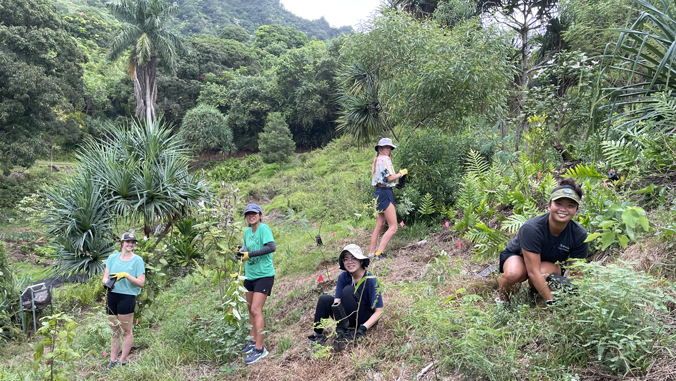
Calculating carbon dioxide emissions, utilizing on-island recycling programs, and the impacts of raising grain-fed versus grass-fed cattle were some of the capstone projects completed at Kualoa Ranch by five graduating seniors from the University of Hawaiʻi at Mānoa bachelor of arts in sustainability program.
Led by the Institute for Sustainability and Resilience (ISR), students successfully presented their capstone research projects to UH faculty and Kualoa leadership on December 12.
Student Catherine McGrath calculated how much carbon dioxide is emitted or sequestered within this location, and provided recommendations regarding data collection and future projects based on the findings.
“This was an important opportunity for students because it gave us the chance to apply skills that we had learned and acquired over the past years of our undergraduate degrees,” said McGrath. “It was challenging to start a project like this from scratch, but it was especially gratifying to see it come to fruition and to be able to provide the ranch with tangible recommendations based on work made possible by our experience and time as sustainability majors.”
Applying knowledge in real-world setting
This inaugural partnership between ISR and Kualoa Ranch allowed students to apply the knowledge and skills they learned in the sustainability program in a real-world setting—at the 4,000-acre nature reserve and working cattle ranch located on the windward side of Oʻahu.
“Everyone I spoke with and collaborated with was so kind, helpful and excited about what we were doing at Kualoa,” said student Maiana Villegas. “We got to take part in two service learning days, which helped us gain a better understanding of what goes on behind the scenes and helped strengthen relationships with the coordinators who facilitated this partnership.”
Villegas’ project was drafting and proposing a tourist survey for visitors to Kualoa Ranch which focused on asking them sustainability, land stewardship and Hawaiian history questions. By creating this survey and collecting data she hoped to gain a greater understanding of tourists’ knowledge on Kualoa’s sustainability efforts as well as their overall education on Hawaiian history and terminology.
Other student projects tackled a range of sustainability issues related to the ranch including: assessing how the ranch might tap into existing on-island recycling and compost programs to minimize landfill-bound plastics; conducting a survey of institutional purchasing programs that support local agriculture across the country and in Hawaiʻi; and a study of the environmental impacts of raising grain-fed versus grass-fed cattle, while providing recommendations to the ranch in the context of climate change.
Located at UH Mānoa, ISR’s mission is to provide campus-wide leadership and coordination for interdisciplinary education, research and outreach related to environmental sustainability and community resilience in Hawaiʻi and abroad.

